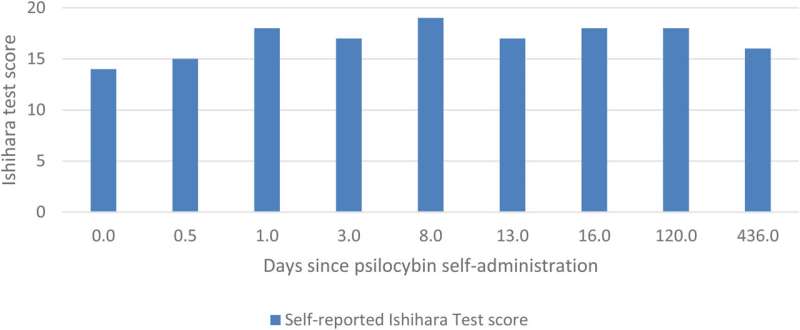May 3, 2023 report
This article has been reviewed according to Science X's editorial process and policies. Editors have highlighted the following attributes while ensuring the content's credibility:
fact-checked
trusted source
proofread
Case report: Magic mushrooms may induce lasting improvements in color-blind vision

Researchers at the Department of Psychiatry and Psychology, Center for Behavioral Health, Neurological Institute at the Cleveland Clinic in Ohio have authored a case report on the positive effects of psilocybin on color blindness.
Published in the journal Drug Science, Policy and Law, the researchers highlight some implications surrounding a single reported vision improvement self-study by a colleague and cite other previous reports, illustrating a need to understand better how these psychedelics could be used in therapeutic settings.
Past reports have indicated that people with color vision deficiency (CVD), usually referred to as color blindness, experience better color vision after using lysergic acid diethylamide (LSD) or psilocybin (magic mushrooms). There is a lack of scientific evidence for these claims, as researching the effects of these drugs has been highly restricted.
Color vision depends on a cluster of three types of photoreceptors known as cones—red, green, and blue sensing retinal photoreceptors with light-sensitive pigments. If one or more of these pigments is missing, the result is color blindness. Red-green CVD, which results in difficulties distinguishing between red and green, is typically an inherited condition caused by X chromosome-linked recessive mutations in genes coding for components of cones. It is the most common type of CVD, occurring in 8% of men and 0.5% of women.
People with color blindness can only perceive around 10% of hues and color variations compared with normal color vision, with some forms having no ability to distinguish red and green.
Life with color blindness can be difficult; aside from making the occasional wardrobe color mistakes, it can make maps and infographics indecipherable, disguise the ripeness of fruits or freshness of meat in the fridge, and can restrict career choices where color sight is an advantage or required, such as airline pilot, graphic artist and textile and paint-related jobs.
There is no treatment to correct color blindness, although there have been attempted workarounds. One of the more accessible options for some specific types of color blindness is glasses with special lenses, like the ones made by EnChroma, which selectively filter out wavelengths of light at the point where red and green frequencies overlap for a person with color blindness, making the two distinct.
In the current case, a subject with red-green CVD (mild deuteranomalia) self-administered the Ishihara Test to quantify the degree and duration of color vision improvement after using 5 g of dried psilocybin magic mushrooms. Self-reported Ishihara Test data from the subject revealed partial improvement in CVD, peaking at 8 days and persisting for at least 16 days post-psilocybin administration.
In previous experiences that led to the more controlled self-experiment, the subject reported using MDMA once, psilocybin mushrooms twice, oral LSD five times, and inhaling DMT (dimethyltryptamine) seven times. After these prior episodes of psychedelic use, the subject had noted improvement in color vision persisting for months.
Before mushroom ingestion, the subject self-administered the Ishihara Test, a series of graphics composed of a mosaic of dots varying in color, hue and size. The cards of the test are designed to hide test images from someone with color blindness that would be clearly visible to someone with color vision. For example, a graphic of red and green dots might have the number "3" composed of only red dots, clearly apparent to most but invisible to the color-blind individual.
During this baseline test, the subject reported scoring 14 on plates 1–21, indicating mild red-green blindness, with an additional set of four cards indicating deuteranomalia, a version of CVD that makes greens look more reds.
While the subject reported intensification of colors under the acute effects of psilocybin, the score showed only slight improvement to 15 at 12 hours post-administration. By 24 hours post-mushroom administration, the score reached 18, one above the cut-off of 17 required by the Ishihara Test for the classification of normal color vision. The score peaked at 19 on day eight and was still tuned into the range of normal vision four months later.
The researchers suggest it is likely that psychedelic-induced visual phenomena result primarily from alterations in brain activity rather than their direct effects on the retina and peripheral eye. Based on the time delay between psilocybin and color vision, the mushroom may have catalyzed a learning process around color interpretation, possibly altering the connectivity between visual regions.
Interestingly, though not in the case report, filtered wavelength glasses, like EnChroma, do not work instantly. It takes around 15 minutes to an hour for the effect of the filtering to "turn on" and the newly separated waves to be interpreted by the brain, also suggesting that a brain learning process is required.
Despite color blindness typically resulting from a genetic defect, the report authors say that if this single use of psilocybin can produce long-lasting partial improvements in color vision, it raises the possibility of psilocybin inducing durable alterations in visual processing in some people. The authors conclude that future research in this area should determine whether psilocybin-induced improvement occurs in more severe cases, explore the relationship of psilocybin dosage to improvement and investigate the underlying mechanism of this curious phenomenon.
More information: Brian S. Barnett et al, Case report: Prolonged amelioration of mild red-green color vision deficiency following psilocybin mushroom use, Drug Science, Policy and Law (2023). DOI: 10.1177/20503245231172536
© 2023 Science X Network




















